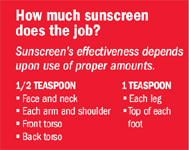Protect skin from sun damage: Educate patients
Pharmacists are in a good position to tell patients that sand, water, snow, and clouds reflect and intensify the sun's rays, causing unsuspected sun damage, even in shade, and that protecting skin from sun damage should be incorporated into a daily routine.

Key Points
Pharmacists are in a good position to tell patients that sand, water, snow, and clouds reflect and intensify the sun's rays, causing unsuspected sun damage, even in shade, and that protecting skin from sun damage should be incorporated into a daily routine.
Statistics
The sun produces ultraviolet (UV) radiation A and B. UVB has traditionally been associated with sunburns, while UVA has been known to penetrate the skin, causing premature aging of the skin and skin damage, leading to skin cancers.
Everyone is at risk

Increased risk factors include tropical regions or high altitudes, infrequent exposure to the sun, skin blemishes (moles, freckles, etc.), or light-colored hair (blond to light brown and even red hair). Other factors associated with increased risk are a personal or family history of skin cancer or autoimmune disease.
Pharmacists should counsel patients about drugs that may cause photosensitivity, such as birth-control products, tetracycline, sulfa drugs, some antibiotics, nonsteroidal anti-inflammatory drugs, phenothiazines, tricyclics, thiazide diuretics, and sulfonylureas, to name a few.
Application
Patients should be told that time of application, reapplication, and use of the correct amount of sunscreen are all necessary if they seek to achieve the labeled sun protection factor (SPF).
Two tablespoons of product should be used to cover the entire body. This can be broken down into ½teaspoon to 1 teaspoon per body part.
Sunscreen should be applied 15 to 30 minutes before exposure, allowing the product to be absorbed by the skin. It should be reapplied every 2 hours. It should also be reapplied after heavy sweating, towel-drying, and exposure to water, even if the product is labeled as waterproof or water-resistant. A waterproof product will provide protection in water for 80 minutes; a water-resistant will protect for 40 minutes.
Patients should understand that sunscreens and sun blocks must be used in conjunction with clothing, hats, and sunglasses labeled as UV protective. In addition, it is essential that they limit their sun exposure as well as exposure at times of peak UV concentration.
Studies have shown that across the board, sunscreen is used as first-line protection from the sun's rays without recourse to the other recommendations mentioned above.
Choosing a product
Patients should be told that sun blocks, while usually found to be uncomfortable and unattractive, offer effective UVA and UVB protection, while sunscreens allow UV radiation to penetrate the skin at less than the normal rate.
The American Academy of Dermatology recommends using a product claiming "UVA/UVB" protection or labeled as "broad spectrum" and with a SPF of 15 or greater.
Patients should be told that SPF only indicates how long a person can be exposed to the sun's UVB radiation without burning. An SPF of 30 should allow exposure to UVB radiation 30 times longer than otherwise.
Patients should also be told that there are no standardized labels for the more damaging, deeper-penetrating UVA radiation and that going any higher than an SPF of 30 will not significantly boost protection since the sun's cumulative effects increase and the product's integrity decreases with lengthy exposure.
Shielding skin from the sun's UV rays through the use of broad-spectrum sunscreens and compliance with protective guidelines will effectively reduce the chance of skin cancer developing in an individual's lifetime.
STEPHEN MILSTEAD is a full-time pharmacist with Trinity Hospital, and a part-time clinical pharmacist at Mercy Hospital, Birmingham, Ala.